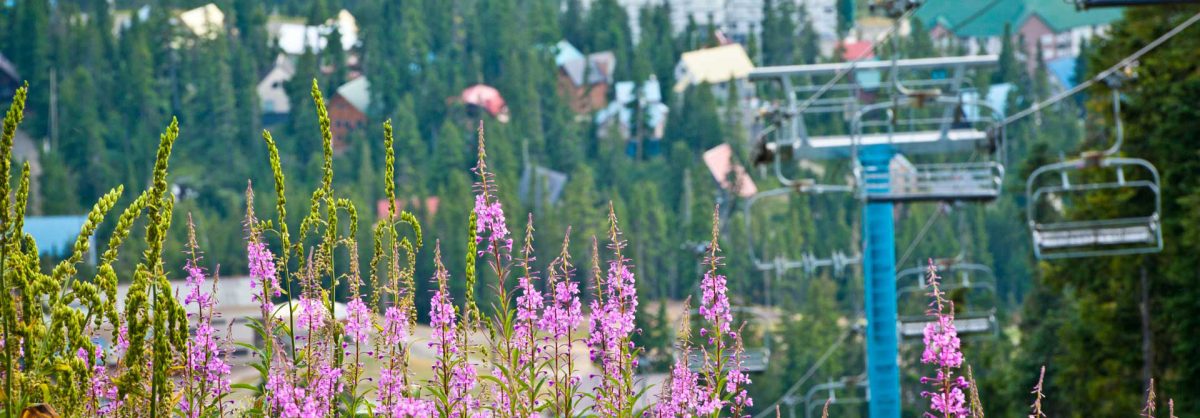
Flora and Fauna
Mount Washington is a haven for diverse flora and fauna, reflecting its varied elevations and microclimates. The diverse habitats, from alpine meadows to subalpine forests, support a wide range of plant and animal species, making it a critical area for biodiversity. Here’s a glimpse into the rich animal and plant life you can encounter:
FAUNA

VANCOUVER ISLAND MARMOT: The Vancouver Island marmot is one of the rarest species in the world, listed as Endangered and found only on Vancouver Island. Vancouver Island marmots are easy to recognize by their rich chocolate brown fur with contrasting white patches on their nose, chin, forehead and chest. They live on the south and west-facing slopes of alpine meadows usually above 1000m. Keep an eye out for marmots on the slopes of Mount Washington in the summer months only – they hibernate from mid-September until late April or early May! Hibernation helps these furry creatures survive the alpine winters when food is not readily available.

VANCOUVER ISLAND BLACK BEAR: Black bears can be found across Vancouver Island. The Vancouver Island population is generally blacker and slightly larger than those found on the mainland. Black bears are omnivores and will eat just about anything that is available to them; berries, insects, nuts and grasses, meat like deer and elk are all on the menu! In BC especially, bears will gorge on spawning salmon in late summer and autumn as they prepare for winter hibernation. If you spot one on Mount Washington you can be assured it is a black bear.
BLACK-TAILED DEER: The deer of Vancouver Island are a subspecies of mule deer found along the coast from northern California up into British Columbia. Black tailed deer are very common on the Island and are regular visitors to the resort and Mount Washington Village.
ROOSEVELT ELK: Once widespread throughout southern British Columbia, the vast majority of BC’s Roosevelt elk now live exclusively on Vancouver Island. The largest of the elk family, the Roosevelt elk can reach 500kg at maturity, and live for approximately 12-15 years. They migrate locally, moving to lower browsing sites as the winter approaches, and heading upwards into subalpine areas with young, seasonal growth in the late spring. The Roosevelt elk graze on grasses & new shoots during the warm months, and browse small woody plants in the winter.

BIRDS: On the slopes of Mount Washington, the Gray Jay is more commonly called the Whiskey Jack, and can be spotted year-round flitting through the trees to perch on railings and roofs in search of a snack. These cheerful little birds are fearless and their venturesome behaviour both amuses and (sometimes) annoys visitors to the alpine. Other birds are the chestnut-backed chickadee, red-breasted nuthatch, winter wren and kinglet, Steller’s jay, blue grouse, ruffed grouse and white-tailed ptarmigan. Caution: please don’t feed the wildlife!
COUGAR: Cougars, also known as mountain lions or pumas, are the largest wild cat species in BC and can be found throughout the province. Vancouver Island, in particular, is home to the highest density of cougars in the world. These elusive animals are rare to spot as they tend to avoid human activity and prefer dense forested regions. As solitary cats, cougars are not typically spotted together, unless it is a mother with her young.
FLORA
Alpine Meadows: In the high alpine meadows, you’ll find hardy plants like alpine lupine, mountain heather, and dwarf arctic willows. These plants are adapted to harsh conditions with short growing seasons. Vibrant wildflower displays in summer, including species like Indian paintbrush, alpine aster, and glacier lilies. These meadows offer a colorful contrast against the rugged alpine backdrop.
Subalpine Forests: Lower elevations are dominated by subalpine forests featuring conifers such as Subalpine fir, Yellow Cedar, Amabilis Fir, Mountain Hemlock, Western White Pine, Shore Pine (Pinus contorta var. contorta), Douglas Fir, and Western Hemlock. The undergrowth includes shrubs like Mountain Ash, Twinberry and various species of Blueberry, including bog, dwarf, narrow-leafed, Alaska and black huckleberry. Forests of Western Redcedar, Grand Fir, and Creeping Juniper provide a lush, green canopy and are home to mosses, lichens, and ferns, contributing to the rich, verdant environment.
Wetlands and Streams: These areas are crucial for maintaining local biodiversity and provide habitat for various wildlife species. In wetter areas and along streams, you might find skunk cabbage, Jeffrey’s Shooting Star, White Bog Orchid, King Gentian and various sedges and grasses. These plants thrive in the moist, nutrient-rich soil.
A complete guide with information on flowering plants and trees to be found in the Mount Washington area is available on the Strathcona Wilderness Institute website.


Hello, curious humans! I’ve got a few friendly tips to keep our mountain home as cozy and delightful as possible.
Respect Wildlife:
Remember to give us furry folk our space! Observe from a distance so we can go about our important business without feeling disturbed, especially when we’re busy foraging or taking care of our families.
Stay on Trails:
Those winding paths are our favorite ways to get around. By sticking to them, you help protect our delicate alpine and subalpine homes. So, please avoid wandering off and trampling the plants we all love!
Pack Out Trash:
We like our home to be as clean as possible, just like you do. So, take all your litter with you when you leave. That way, we can all enjoy a pristine environment and keep our home looking and feeling great
Thanks for helping us keep our mountain paradise in tip-top shape! We appreciate it, and we’ll see you around!
— Morgan, The Marmot
Adventure Guide